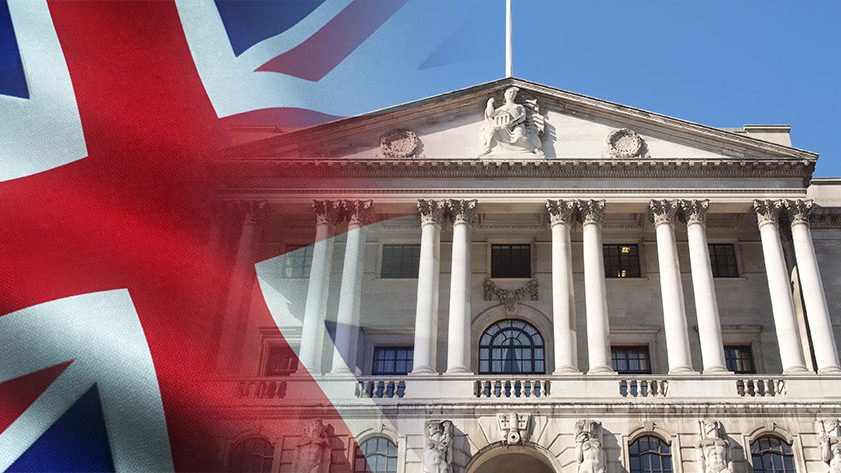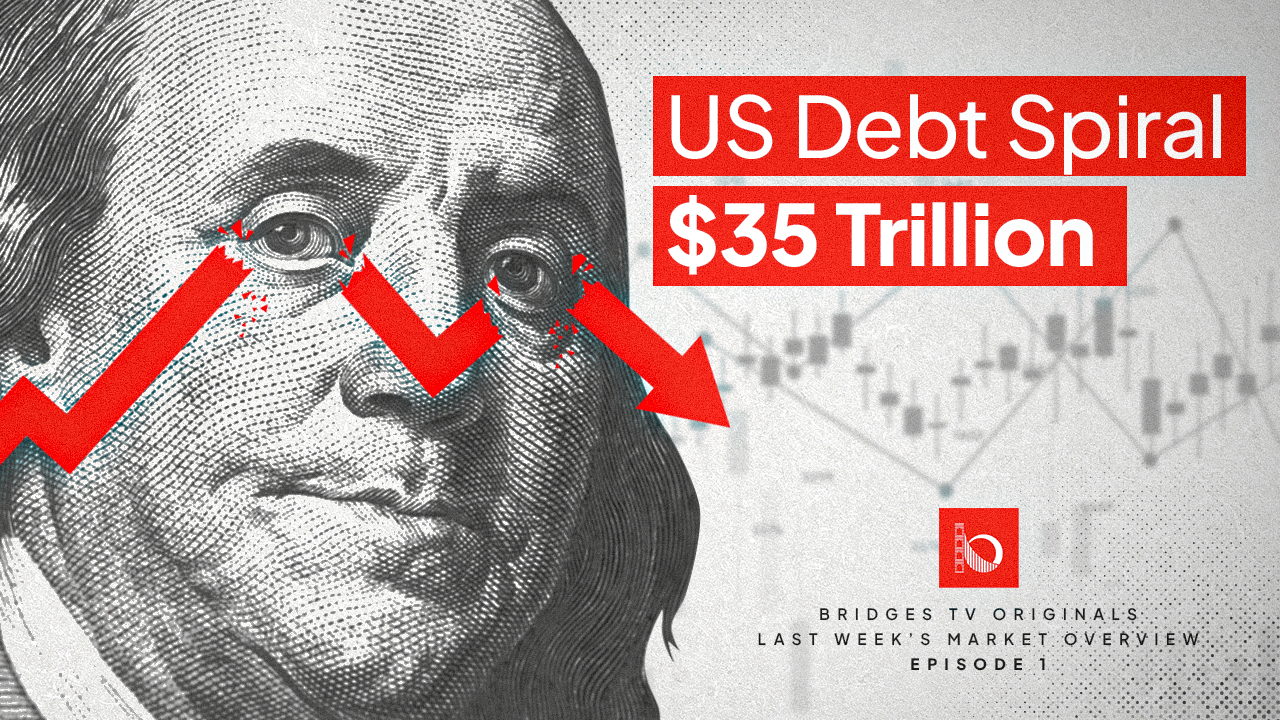Moody’s Downgrade Sparks U.S. Market Turbulence
On May 16, Moody’s downgraded the US sovereign credit rating from the top level Aaa (negative) to Aa1 (stable) for the first time since 1917 (Abad, 2025). It is worth mentioning that Standard & Poor’s (S&P) and Fitch Ratings, which are major rating agencies alongside Moody’s, have already downgraded the US rating in 2011 and 2023, respectively (Peterson Foundation, 2025).
Moody’s stated several reasons for its downgrade decision, such as rising national debt, increasing interest payments, and persistent budget deficits. First of all, the US debt has marked 36 trillion dollars (Wearden, 2025), with Moody’s assessment showing it may jump to 134% of GDP by 2035, up from 98% in 2024 (Abad, 2025). Interest payments are also a considerable share of US federal expenditure, presumably increasing to 30% by 2035, up from 9% in 2021 (Bourne, 2025). Finally, the budget deficit is expected to be around 7% of GDP and even rise to 9% by 2034, with the ongoing increase in tax cuts and spending (Abad, 2025).
Just shortly after Moody’s downgrade, the financial market reacted with notable volatility. On May 21, the S&P 500, Dow Jones Industrial Average, and Nasdaq dropped by 1.6%, 1.9%, and 1.4%, respectively in equity markets (Choe, 2025). On the same day, the price of US bonds also fell, increasing 30-year Treasure yield over 5% for the first time in 18 months (Wearden, 2025). Moreover, the US dollar index (strength of the dollar against other major currencies) also faces fluctuations, yet it is preserving its overall strength (Market Watch, 2025). Still, some seek better safe-haven assets to avoid uncertainty. To elaborate, the price of gold has risen, and Bitcoin marked nearly a peak level of 100,000 dollars (Zilber, 2025).
Moody’s downgrade has potential outcomes for the government, consumers, and investors. To begin with, as investors may be hesitant to lend to the government, the US may have to endure higher interest rates on debt due to, resulting in increased costs for financing the government’s deficit. Furthermore, higher Treasury yields may also push mortgage and other rates up, harming consumers. Additionally, investors may lose their confidence due to damaged government reputation and high market volatility, increasing risk premiums. All in all, while the market volatility is concerning, the long-term consequences depend on the US government’s ability to carry out corrective reforms.

Bank of England’s Caution on Rate Cuts
BoE Chief Economist Huw Pill (2025) stated his concerns about the rate cuts in the UK, implying that more rate cuts are to come at a faster pace. The BoE decreased the rate to 4.25% in May 2025, implementing its fourth cut since August 2024, and one more cut is expected this year (Barnett, 2025). The main concern is regarding the increasing inflationary pressures mainly due to wage growth. In April, the inflation rate hit 3.5%, up from 2.6% in March, exceeding the BoE’s projection of 3.3% (Kollewe, 2025). According to Kollewe (2025), the main drivers of inflation are increasing prices for energy, water, and airfares, along with taxes.
The rate cuts have brought several consequences. Firstly, with the declining rate, mortgage rates have also dropped, lowering the borrowing costs for consumers (Meadows, 2025). However, if the inflationary pressures remain persistently high, authorities may feel forced to stop reductions and even increase the rate to avoid inflation, dampening the borrowing costs. This harms certainty in the lending markets. Likewise, the bond market is also experiencing slight shifts, increasing uncertainty (Dikshit & Mathur, 2025). Finally, after the inflationary pressures, the British pound appreciated against the US dollar, marking the highest rate in the last three years (Dikshit & Mathur, 2025). However, the appreciation has not been persistent enough to deal with the inflationary pressures through the decreased import prices.
To wrap up, Huw Pill advocates for a cautious approach to rate reductions. Considering that the UK has already implemented four cuts, and one more is anticipated, gradual cuts are more likely to better anchor the inflation expectations, easing the pressures and uncertainty.

Initial Public Offerings (IPO) Reform in Spain
Spain is planning to undertake vital reforms to the Initial Public Offerings (IPO) regulations to increase flexibility and resilience in the capital market. The current window for companies to go public (sell shares) is five days after the government approves the listing of “publicly traded” companies that seek to attract investments to expand capital. Nonetheless, this period is significantly short when there are volatility and uncertainty in the market, discouraging companies from joining the IPO. For instance, Europastry, a goods company, and Tendam, a fashion company, postponed their IPO twice in 2024 (Jopson & Muela, 2025). The companies stated the reason was market volatility due to geopolitical uncertainties, such as the US election.
The new rule will make it available for companies to wait for profitable market conditions, with an 18-month window (Jopson & Muela, 2025). The reform aligns with the EU Listing Act that aims to simplify the IPO process and enhance capital market effectiveness. Jopson and Muela (2025) also cite that the government aims to include small businesses as well, diverging its initial target for companies valued at over 500 million euros. Overall, the reform will allow companies to go public in favorable market conditions, making Spain an attractive destination for investments. Nevertheless, the extended window will require strengthened monitoring mechanisms to ensure that companies comply with their obligations.
References
Abad, R. O. (2025, May 19). End of an era—Moody’s downgrades US to Aa1. Western Asset. https://www.westernasset.com/us/en/research/blog/end-of-an-era-moodys- downgrades-us-to-aa1-2025-05-19.cfm
Barnett, J. (2025, May 21). Interest rates ‘will be cut just one more time this year’. The Times. https://www.thetimes.co.uk/article/interest-rates-will-be-cut-just-one-more-time- this-year-5wc0gdxqc
Bourne, R. (2025, May 21). No more excuses: US politicians deserve their ratings downgrade. The Times. https://www.thetimes.com/business-money/economics/article/no-more-excuses- us-politicians-deserve-their-ratings-downgrade-6c600952g
Choe, S. (2025, May 21). Wall Street tumbles under the weight of rising Treasury yields and US debt worries. AP News. https://apnews.com/article/stocks-markets-oil-trump-tariffs- 8f9b85dc446a9d795806d82467747691
Dikshit, T., & Mathur, R. (2025, May 21). UK’s FTSE 100 inches lower as market assesses inflation data, mixed earnings. Reuters. https://www.reuters.com/world/uk/uks-ftse-100- inches-lower-market-assesses-inflation-data-mixed-earnings-2025-05-21/
Jopson, B., & Muela, C. (2025, May 21). US government bonds drop as worries over Trump’s tax bill flare up. Financial Times. https://www.ft.com/content/6a9a438b-a74b-4d86-8331- 5ff0bd091e6b
Kollewe, J. (2025, May 21). UK inflation jumps to 3.5% in April on higher energy, water, road tax and air fare prices – as it happened. The Guardian. https://www.theguardian.com/business/live/2025/may/21/uk-inflation-forecast-jumped- april-higher-household-bills-reeves-g7-canada-business-live
Market Watch. (2025, May 22). U.S. Dollar Index (DXY) overview. https://www.marketwatch.com/investing/index/dxy
Meadows, S. (2025, May 22). Inflation rises – Bank of England rate cuts in doubt. Mortgage Introducer. https://www.mpamag.com/uk/mortgage-industry/market-trends/inflation- rises-bank-of-england-rate-cuts-in-doubt/536547
Peter G. Peterson Foundation. (2025, May 19). Moody’s downgrade of U.S. credit rating highlights risks of rising national debt. https://www.pgpf.org/article/moodys-downgraded-its-us- credit-rating-and-warns-that-recent-policy-decisions-will-worsen-fiscal-outlook
Pill, H. (2025, May 20).The courage not to act: Remarks by Huw Pill. Bank of England. https://www.bankofengland.co.uk/speech/2025/may/huw-pill-speech-at-the- barclays-briefing
Wearden, G. (2025, May 19). Stock markets and US dollar drop, and bond yields rise, after US credit rating downgrade; EC cuts eurozone growth forecast – as it happened. The Guardian. https://www.theguardian.com/business/live/2025/may/19/stock-markets-bonds- us-credit-rating-downgraded-by-moodys-dollar-business-live-news
Zilber, A. (2025, May 21). Bitcoin hits record as stocks, bonds retreat amid market uncertainty. New York Post. https://nypost.com/2025/05/21/business/bitcoin-soars-to-all-time-high-as- stocks-bonds-retreat-amid-uncertainty/








